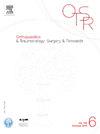前臂慢性劳累隔室综合征的诊断标准:系统综述。
IF 2.3
3区 医学
Q2 ORTHOPEDICS
引用次数: 0
摘要
背景:前臂慢性劳累性椎间室综合征(CECS)的特点是在反复活动时前臂椎间室压力增高。目的:我们旨在全面描述前臂慢性劳累性间室综合征(CECS)的诊断方法,以评估是否能找到更有效的诊断策略:我们使用 PubMed、Google Scholar、Cochrane Library 和 Science Direct 数据库检索文章。我们使用网目词("慢性劳累性室间隔综合征 "或 "慢性劳累性室间隔综合征 "或 "劳累性室间隔")和("前臂 "或 "上肢")进行了多次检索。纳入标准为有关前臂 CECS 的前瞻性或回顾性研究,包括病例报告。我们采用了 PRISMA 指南。我们采用 GRADE 方法对纳入的研究进行了严格评估:结果:共筛选出 625 篇文章,纳入 33 项研究。其中有 590 名患者(505 名男性和 85 名女性),平均年龄为 26.6 岁。其中 282 人参加过精英赛。摩托车和越野摩托车是最常见的运动(66%)。采用了六种诊断方法。在 26 项研究中,室间隔内压(ICP)测量是最常用的方法。有 9 项研究采用了磁共振成像,只有 2 项研究采用了肌电图。一项研究报告使用手动测力计测量了握力,一项研究比较了锻炼前后的前臂围度,还有一项研究使用了肌电测量法。观察了各种锻炼方案。在 14 项研究中,使用手握力器进行压力测试是最常见的方案。运动时间从 2 分钟到 60 分钟不等:现有数据并没有提供足够的证据来支持ICP测量以外的其他诊断方法,鉴于缺乏正式的验证,应谨慎使用。无创方法可能更易于使用,但应进一步研究:证据等级:III。本文章由计算机程序翻译,如有差异,请以英文原文为准。
Diagnostic criteria of forearm Chronic Exertional Compartment Syndrome: A systematic review
Background
Chronic Exertional Compartment Syndrome (CECS) of the forearm is characterized by an increase of the pressure in the forearm compartments during repeated activities. Its diagnosis is challenging because of the lack of clearly established diagnostic criteria.
Purpose
We aimed to provide a comprehensive description of the diagnostic methods used for CECS of the forearm, to assess if a more effective diagnosis strategy could be identified.
Methods
We used PubMed, Google Scholar, Cochrane Library and Science Direct databases to search articles. We carried out multiple searches using the mesh terms (“Chronic Exertional Compartment Syndrome” OR “Chronic compartment syndrome” OR “Exertional compartment”) AND (“forearm” OR “upper limb”). Inclusion criteria were prospective or retrospective studies on CECS of the forearm including case reports. We used PRISMA guidelines. The included studies were critically appraised using GRADE approach.
Results
A total of 625 articles were screened and 33 studies were included. It represented 590 patients (505 men and 85 women), with a mean age of 26.6 years old. Among them, 282 competed at an elite level. Motorcycling and motocross were the most frequent sports (66%). Six diagnostic methods were employed. Intra-compartmental pressure (ICP) measurement was the most frequently used method in 26 studies. Magnetic resonance imaging was performed in 9 studies, while electromyography was employed in only 2 studies. One study reported the measurement of grip strength using a manual dynamometer, one study compared forearm circumference before and after effort, and one used myotonometry. Various exercise protocols were observed. Stress-testing using a hand-grip was the most common protocol in 14 studies. Exercise duration varied from 2 min to 60 min.
Conclusion
Existing data do not provide sufficient evidence to favor an alternative diagnostic method over ICP measurements that should be used cautiously given the absence of formal validation. Non-invasive methods might be easier to use, but should be subjected to further research.
Level of evidence
III.
求助全文
通过发布文献求助,成功后即可免费获取论文全文。
去求助
来源期刊
CiteScore
5.10
自引率
26.10%
发文量
329
审稿时长
12.5 weeks
期刊介绍:
Orthopaedics & Traumatology: Surgery & Research (OTSR) publishes original scientific work in English related to all domains of orthopaedics. Original articles, Reviews, Technical notes and Concise follow-up of a former OTSR study are published in English in electronic form only and indexed in the main international databases.

 求助内容:
求助内容: 应助结果提醒方式:
应助结果提醒方式:


